Input interpretation

H_2SO_4 sulfuric acid + NaI sodium iodide + NaNO_2 sodium nitrite ⟶ H_2O water + I_2 iodine + NO nitric oxide + NaHSO_4 sodium bisulfate
Balanced equation
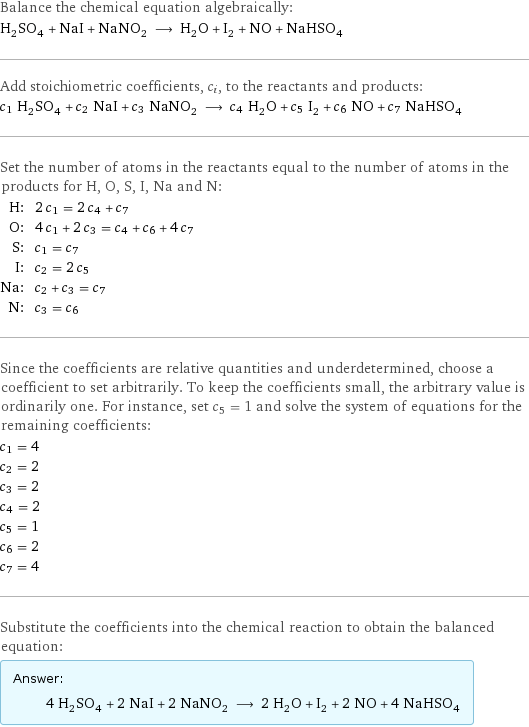
Balance the chemical equation algebraically: H_2SO_4 + NaI + NaNO_2 ⟶ H_2O + I_2 + NO + NaHSO_4 Add stoichiometric coefficients, c_i, to the reactants and products: c_1 H_2SO_4 + c_2 NaI + c_3 NaNO_2 ⟶ c_4 H_2O + c_5 I_2 + c_6 NO + c_7 NaHSO_4 Set the number of atoms in the reactants equal to the number of atoms in the products for H, O, S, I, Na and N: H: | 2 c_1 = 2 c_4 + c_7 O: | 4 c_1 + 2 c_3 = c_4 + c_6 + 4 c_7 S: | c_1 = c_7 I: | c_2 = 2 c_5 Na: | c_2 + c_3 = c_7 N: | c_3 = c_6 Since the coefficients are relative quantities and underdetermined, choose a coefficient to set arbitrarily. To keep the coefficients small, the arbitrary value is ordinarily one. For instance, set c_5 = 1 and solve the system of equations for the remaining coefficients: c_1 = 4 c_2 = 2 c_3 = 2 c_4 = 2 c_5 = 1 c_6 = 2 c_7 = 4 Substitute the coefficients into the chemical reaction to obtain the balanced equation: Answer: | | 4 H_2SO_4 + 2 NaI + 2 NaNO_2 ⟶ 2 H_2O + I_2 + 2 NO + 4 NaHSO_4
Structures
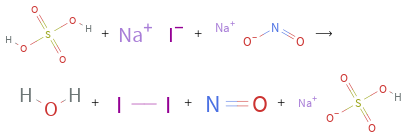
+ + ⟶ + + +
Names

sulfuric acid + sodium iodide + sodium nitrite ⟶ water + iodine + nitric oxide + sodium bisulfate
Reaction thermodynamics
Enthalpy
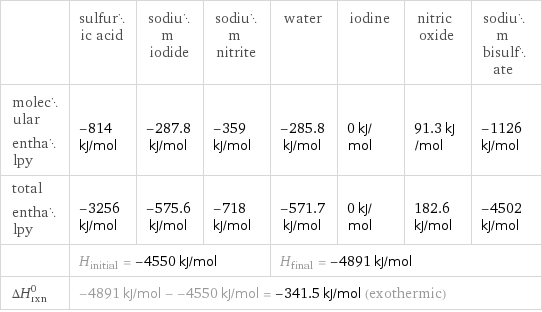
| sulfuric acid | sodium iodide | sodium nitrite | water | iodine | nitric oxide | sodium bisulfate molecular enthalpy | -814 kJ/mol | -287.8 kJ/mol | -359 kJ/mol | -285.8 kJ/mol | 0 kJ/mol | 91.3 kJ/mol | -1126 kJ/mol total enthalpy | -3256 kJ/mol | -575.6 kJ/mol | -718 kJ/mol | -571.7 kJ/mol | 0 kJ/mol | 182.6 kJ/mol | -4502 kJ/mol | H_initial = -4550 kJ/mol | | | H_final = -4891 kJ/mol | | | ΔH_rxn^0 | -4891 kJ/mol - -4550 kJ/mol = -341.5 kJ/mol (exothermic) | | | | | |
Gibbs free energy
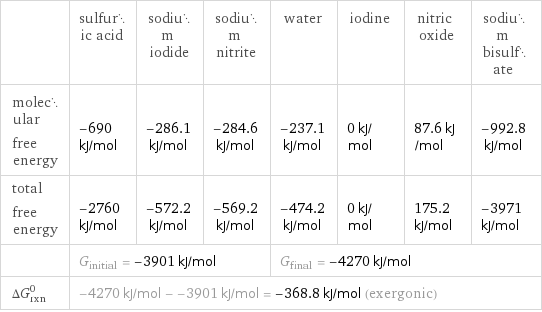
| sulfuric acid | sodium iodide | sodium nitrite | water | iodine | nitric oxide | sodium bisulfate molecular free energy | -690 kJ/mol | -286.1 kJ/mol | -284.6 kJ/mol | -237.1 kJ/mol | 0 kJ/mol | 87.6 kJ/mol | -992.8 kJ/mol total free energy | -2760 kJ/mol | -572.2 kJ/mol | -569.2 kJ/mol | -474.2 kJ/mol | 0 kJ/mol | 175.2 kJ/mol | -3971 kJ/mol | G_initial = -3901 kJ/mol | | | G_final = -4270 kJ/mol | | | ΔG_rxn^0 | -4270 kJ/mol - -3901 kJ/mol = -368.8 kJ/mol (exergonic) | | | | | |
Equilibrium constant
![Construct the equilibrium constant, K, expression for: H_2SO_4 + NaI + NaNO_2 ⟶ H_2O + I_2 + NO + NaHSO_4 Plan: • Balance the chemical equation. • Determine the stoichiometric numbers. • Assemble the activity expression for each chemical species. • Use the activity expressions to build the equilibrium constant expression. Write the balanced chemical equation: 4 H_2SO_4 + 2 NaI + 2 NaNO_2 ⟶ 2 H_2O + I_2 + 2 NO + 4 NaHSO_4 Assign stoichiometric numbers, ν_i, using the stoichiometric coefficients, c_i, from the balanced chemical equation in the following manner: ν_i = -c_i for reactants and ν_i = c_i for products: chemical species | c_i | ν_i H_2SO_4 | 4 | -4 NaI | 2 | -2 NaNO_2 | 2 | -2 H_2O | 2 | 2 I_2 | 1 | 1 NO | 2 | 2 NaHSO_4 | 4 | 4 Assemble the activity expressions accounting for the state of matter and ν_i: chemical species | c_i | ν_i | activity expression H_2SO_4 | 4 | -4 | ([H2SO4])^(-4) NaI | 2 | -2 | ([NaI])^(-2) NaNO_2 | 2 | -2 | ([NaNO2])^(-2) H_2O | 2 | 2 | ([H2O])^2 I_2 | 1 | 1 | [I2] NO | 2 | 2 | ([NO])^2 NaHSO_4 | 4 | 4 | ([NaHSO4])^4 The equilibrium constant symbol in the concentration basis is: K_c Mulitply the activity expressions to arrive at the K_c expression: Answer: | | K_c = ([H2SO4])^(-4) ([NaI])^(-2) ([NaNO2])^(-2) ([H2O])^2 [I2] ([NO])^2 ([NaHSO4])^4 = (([H2O])^2 [I2] ([NO])^2 ([NaHSO4])^4)/(([H2SO4])^4 ([NaI])^2 ([NaNO2])^2)](../image_source/4ff46b27798153b8edcf805e9136866b.png)
Construct the equilibrium constant, K, expression for: H_2SO_4 + NaI + NaNO_2 ⟶ H_2O + I_2 + NO + NaHSO_4 Plan: • Balance the chemical equation. • Determine the stoichiometric numbers. • Assemble the activity expression for each chemical species. • Use the activity expressions to build the equilibrium constant expression. Write the balanced chemical equation: 4 H_2SO_4 + 2 NaI + 2 NaNO_2 ⟶ 2 H_2O + I_2 + 2 NO + 4 NaHSO_4 Assign stoichiometric numbers, ν_i, using the stoichiometric coefficients, c_i, from the balanced chemical equation in the following manner: ν_i = -c_i for reactants and ν_i = c_i for products: chemical species | c_i | ν_i H_2SO_4 | 4 | -4 NaI | 2 | -2 NaNO_2 | 2 | -2 H_2O | 2 | 2 I_2 | 1 | 1 NO | 2 | 2 NaHSO_4 | 4 | 4 Assemble the activity expressions accounting for the state of matter and ν_i: chemical species | c_i | ν_i | activity expression H_2SO_4 | 4 | -4 | ([H2SO4])^(-4) NaI | 2 | -2 | ([NaI])^(-2) NaNO_2 | 2 | -2 | ([NaNO2])^(-2) H_2O | 2 | 2 | ([H2O])^2 I_2 | 1 | 1 | [I2] NO | 2 | 2 | ([NO])^2 NaHSO_4 | 4 | 4 | ([NaHSO4])^4 The equilibrium constant symbol in the concentration basis is: K_c Mulitply the activity expressions to arrive at the K_c expression: Answer: | | K_c = ([H2SO4])^(-4) ([NaI])^(-2) ([NaNO2])^(-2) ([H2O])^2 [I2] ([NO])^2 ([NaHSO4])^4 = (([H2O])^2 [I2] ([NO])^2 ([NaHSO4])^4)/(([H2SO4])^4 ([NaI])^2 ([NaNO2])^2)
Rate of reaction
![Construct the rate of reaction expression for: H_2SO_4 + NaI + NaNO_2 ⟶ H_2O + I_2 + NO + NaHSO_4 Plan: • Balance the chemical equation. • Determine the stoichiometric numbers. • Assemble the rate term for each chemical species. • Write the rate of reaction expression. Write the balanced chemical equation: 4 H_2SO_4 + 2 NaI + 2 NaNO_2 ⟶ 2 H_2O + I_2 + 2 NO + 4 NaHSO_4 Assign stoichiometric numbers, ν_i, using the stoichiometric coefficients, c_i, from the balanced chemical equation in the following manner: ν_i = -c_i for reactants and ν_i = c_i for products: chemical species | c_i | ν_i H_2SO_4 | 4 | -4 NaI | 2 | -2 NaNO_2 | 2 | -2 H_2O | 2 | 2 I_2 | 1 | 1 NO | 2 | 2 NaHSO_4 | 4 | 4 The rate term for each chemical species, B_i, is 1/ν_i(Δ[B_i])/(Δt) where [B_i] is the amount concentration and t is time: chemical species | c_i | ν_i | rate term H_2SO_4 | 4 | -4 | -1/4 (Δ[H2SO4])/(Δt) NaI | 2 | -2 | -1/2 (Δ[NaI])/(Δt) NaNO_2 | 2 | -2 | -1/2 (Δ[NaNO2])/(Δt) H_2O | 2 | 2 | 1/2 (Δ[H2O])/(Δt) I_2 | 1 | 1 | (Δ[I2])/(Δt) NO | 2 | 2 | 1/2 (Δ[NO])/(Δt) NaHSO_4 | 4 | 4 | 1/4 (Δ[NaHSO4])/(Δt) (for infinitesimal rate of change, replace Δ with d) Set the rate terms equal to each other to arrive at the rate expression: Answer: | | rate = -1/4 (Δ[H2SO4])/(Δt) = -1/2 (Δ[NaI])/(Δt) = -1/2 (Δ[NaNO2])/(Δt) = 1/2 (Δ[H2O])/(Δt) = (Δ[I2])/(Δt) = 1/2 (Δ[NO])/(Δt) = 1/4 (Δ[NaHSO4])/(Δt) (assuming constant volume and no accumulation of intermediates or side products)](../image_source/87280540b3c203edf9a57e12f7261e82.png)
Construct the rate of reaction expression for: H_2SO_4 + NaI + NaNO_2 ⟶ H_2O + I_2 + NO + NaHSO_4 Plan: • Balance the chemical equation. • Determine the stoichiometric numbers. • Assemble the rate term for each chemical species. • Write the rate of reaction expression. Write the balanced chemical equation: 4 H_2SO_4 + 2 NaI + 2 NaNO_2 ⟶ 2 H_2O + I_2 + 2 NO + 4 NaHSO_4 Assign stoichiometric numbers, ν_i, using the stoichiometric coefficients, c_i, from the balanced chemical equation in the following manner: ν_i = -c_i for reactants and ν_i = c_i for products: chemical species | c_i | ν_i H_2SO_4 | 4 | -4 NaI | 2 | -2 NaNO_2 | 2 | -2 H_2O | 2 | 2 I_2 | 1 | 1 NO | 2 | 2 NaHSO_4 | 4 | 4 The rate term for each chemical species, B_i, is 1/ν_i(Δ[B_i])/(Δt) where [B_i] is the amount concentration and t is time: chemical species | c_i | ν_i | rate term H_2SO_4 | 4 | -4 | -1/4 (Δ[H2SO4])/(Δt) NaI | 2 | -2 | -1/2 (Δ[NaI])/(Δt) NaNO_2 | 2 | -2 | -1/2 (Δ[NaNO2])/(Δt) H_2O | 2 | 2 | 1/2 (Δ[H2O])/(Δt) I_2 | 1 | 1 | (Δ[I2])/(Δt) NO | 2 | 2 | 1/2 (Δ[NO])/(Δt) NaHSO_4 | 4 | 4 | 1/4 (Δ[NaHSO4])/(Δt) (for infinitesimal rate of change, replace Δ with d) Set the rate terms equal to each other to arrive at the rate expression: Answer: | | rate = -1/4 (Δ[H2SO4])/(Δt) = -1/2 (Δ[NaI])/(Δt) = -1/2 (Δ[NaNO2])/(Δt) = 1/2 (Δ[H2O])/(Δt) = (Δ[I2])/(Δt) = 1/2 (Δ[NO])/(Δt) = 1/4 (Δ[NaHSO4])/(Δt) (assuming constant volume and no accumulation of intermediates or side products)
Chemical names and formulas
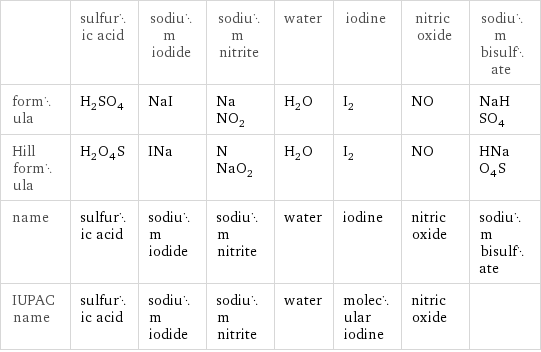
| sulfuric acid | sodium iodide | sodium nitrite | water | iodine | nitric oxide | sodium bisulfate formula | H_2SO_4 | NaI | NaNO_2 | H_2O | I_2 | NO | NaHSO_4 Hill formula | H_2O_4S | INa | NNaO_2 | H_2O | I_2 | NO | HNaO_4S name | sulfuric acid | sodium iodide | sodium nitrite | water | iodine | nitric oxide | sodium bisulfate IUPAC name | sulfuric acid | sodium iodide | sodium nitrite | water | molecular iodine | nitric oxide |
Substance properties

| sulfuric acid | sodium iodide | sodium nitrite | water | iodine | nitric oxide | sodium bisulfate molar mass | 98.07 g/mol | 149.89424 g/mol | 68.995 g/mol | 18.015 g/mol | 253.80894 g/mol | 30.006 g/mol | 120.1 g/mol phase | liquid (at STP) | solid (at STP) | solid (at STP) | liquid (at STP) | solid (at STP) | gas (at STP) | solid (at STP) melting point | 10.371 °C | 661 °C | 271 °C | 0 °C | 113 °C | -163.6 °C | 181.85 °C boiling point | 279.6 °C | 1300 °C | | 99.9839 °C | 184 °C | -151.7 °C | density | 1.8305 g/cm^3 | 3.67 g/cm^3 | 2.168 g/cm^3 | 1 g/cm^3 | 4.94 g/cm^3 | 0.001226 g/cm^3 (at 25 °C) | 1.8 g/cm^3 solubility in water | very soluble | | | | | | surface tension | 0.0735 N/m | | | 0.0728 N/m | | | dynamic viscosity | 0.021 Pa s (at 25 °C) | 0.0010446 Pa s (at 691 °C) | | 8.9×10^-4 Pa s (at 25 °C) | 0.00227 Pa s (at 116 °C) | 1.911×10^-5 Pa s (at 25 °C) | odor | odorless | | | odorless | | |
Units
